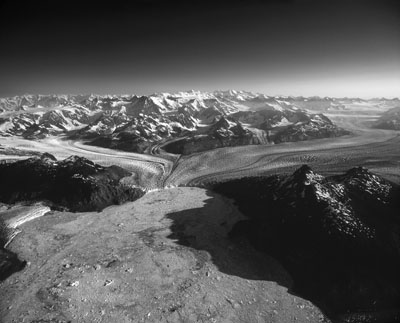
A scanning electron microscope image of cells of Chaetoceros dichaeta, a type of diatom, from Cefarelli et al. 2011.
One of the most interesting aspects of climate dynamics is the role of feedbacks. There are two kinds of feedbacks, positive and negative. This earlier post about Snowball Earth describes a positive feedback, in which Effect One (the freezing of seawater) leads to Effect Two (the reflection of light back into space, which cools the planet) which in turn intensifies Effect One (more seawater freezes.) You can see a positive feedback effect at work in a more familiar environment when there’s a run on a bank: Effect One (the bank looks like it might fail) leads to Effect Two (depositors rush to get their money out of the bank) which strengthens Effect One (the bank, bleeding cash, now looks like it’s in even more trouble.) Positive feedbacks tend to make a system unstable. So they’re not really all that positive in the conversational sense of the word; in most systems, you want to avoid them.
This post, on the other hand, describes the carbonate weathering cycle–a negative feedback effect. In negative feedback, Effect One (warming of the planet from CO2) leads to Effect Two (weathering speeds up, removing CO2 from the air more quickly) which damps down Effect One (with less CO2, the planet cools down again.) Negative feedbacks make systems more stable.
Climate is an incredibly complicated system, with many feedbacks both positive and negative. This article at Science News, Melting icebergs fertilize ocean, describes the discovery of yet another one.
Living things in the ocean are limited by available nutrients, including iron. Some people think we should deliberately dump iron in the ocean to spur the growth of plankton that will suck CO2 from the atmosphere as they grow and then seal it away on the ocean floor when they die and sink to the bottom. Of course, many other people think that this is likely to have a lot of unintended consequences if we do enough of it to make a dent in atmospheric CO2.
But it turns out that icebergs in the Weddell Sea are already doing this, on a smaller scale. Glacier ice has a lot of iron in it compared to seawater, probably due to a combination of dust collected from the atmosphere and sediment from underneath the glacier. When icebergs break off the glacier and melt in the ocean, that iron is released, and thriving communities of algae and plankton spring up around the bergs. The more the planet warms, the faster glaciers flow and the more icebergs end up in the sea; the more icebergs there are, the more carbon gets soaked up by sea life, slowing down warming a little bit.
This effect is probably small compared to other feedbacks that are part of climate change, and it’s not very helpful from a human perspective, since each melting iceberg contributes to rising sea levels. But it’s always interesting to discover a new cog in the great machine of the Earth.
References:
Cefarelli, A.O., Vernet, M. & Ferrario, M.E., 2011. Phytoplankton composition and abundance in relation to free-floating Antarctic icebergs. Deep Sea Research Part II: Topical Studies in Oceanography, 58(11-12), pp.1436-1450.
Lin, H. et al., 2011. Free-drifting icebergs as sources of iron to the Weddell Sea. Deep Sea Research Part II: Topical Studies in Oceanography, 58(11-12), pp.1392-1406.
Raiswell, R., 2011. Iceberg-hosted nanoparticulate Fe in the Southern Ocean: Mineralogy, origin, dissolution kinetics and source of bioavailable Fe.Deep Sea Research Part II: Topical Studies in Oceanography, 58(11-12), pp.1364-1375.
Shaw, T.J. et al., 2011. Input, composition, and potential impact of terrigenous material from free-drifting icebergs in the Weddell Sea. Deep Sea Research Part II: Topical Studies in Oceanography, 58(11-12), pp.1376-1383.
Smith Jr., K.L. et al., 2011. Carbon export associated with free-drifting icebergs in the Southern Ocean. Deep Sea Research Part II: Topical Studies in Oceanography, 58(11-12), pp.1485-1496.

